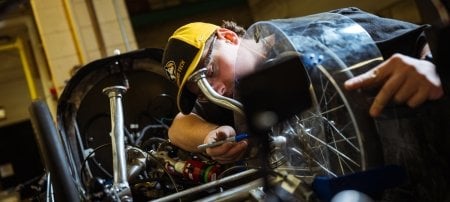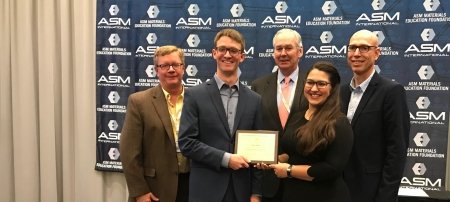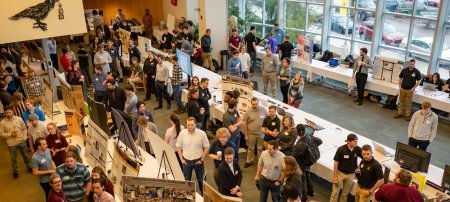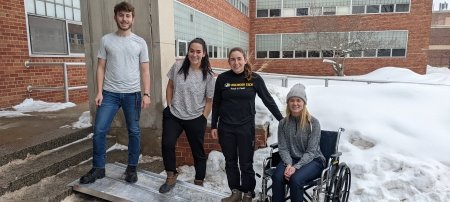Low Tech, High Impact: Students Build a Grain Mill for Africa
Africa is dotted with monuments to what doesn't work. Terry Woychowski wanted to build something that would.
The 1978 mechanical engineering graduate has put the resources of his family foundation behind a Senior Design project to make a grain mill that can withstand the pressures of African village life.
It won't be the first time someone has tried to help subsistence farmers improve their lives by grinding their own maize. Traditionally, farmers have had two choices: hauling grain to the local mill and paying to have it ground into flour, or grinding it themselves by hand with a mortar and pestle.
Plenty of elegant, efficient mills, pumps and other labor-saving devices have been donated to villages, but they rarely lasted long. "They are disassembled for their parts," Woychowski explains. When people are poor, they sacrifice the devices and sell the parts or use them for something else. After all, they can still get their water the old fashioned way by using buckets.
Ten-year-old Solomi Mafuta, of the African village of Sentani, hauls his family's maize to a diesel-powered mill to be ground. The time-consuming task has pulled him away from his studies and to the verge of flunking out of school. His photo is tacked up in the cubicle occupied by Design Team 19 as a reminder of why they are there.
"He would miss school because he had to carry grain," says team member Kate Olkkonen, a mechanical engineering senior.
Woychowski is executive director of General Motors North America vehicle chief engineers and the global chief engineer for trucks, and he has a special interest in advanced propulsion systems, which are notable for their complexity. But when he offered to underwrite a Senior Design team effort to build a grain mill that would work in Africa, he stipulated that it had to be low tech: simple, cheap and made with materials available locally. That meant no motors.
Students found the project intriguing. "It seemed interesting to be working on a project that could be applied in Africa," said Olkkonen. Nathan Fetting added, "And unlike a lot of projects, it will actually be used."
The students were forced to think differently about design. Every dollar, not just every hundred dollars, counted. "It got us away from the parts catalog," said Fetting. Even at that, it was hard to stay simple. "[Team member] Tyler [Blank] had designed a really cool hopper with an intricate feeder, and our advisor asked us why people couldn't just pour the grain in by hand." The hopper was scrapped.
In the end, they built a mill with Solomi in mind. It's powered by an old bicycle: a 10-year-old boy could hop on and grind his family's maize just by pumping the pedals. It produces a coarse flour, which is cooked in boiling water. The end result is nshima, a staple dish in Malawi that looks like mashed potatoes. "We sent some to a family from Malawi living in the Detroit area, and they served it over Easter," Fetting said. "Even their kids liked it."
John Beard, associate professor of mechanical engineering-engineering mechanics, is the team's advisor and is proud of its success. "It's hard to make something simple," he said. "These students had to learn all kinds of things from a hundred years ago." It also answers one of Africa's three greatest needs, he said: the other two are education and clean drinking water.
Jamie Woychowski, Terry's daughter and executive director of the Woychowski Charitable Foundation, will travel to Zambia to transfer the design plans and spearhead the manufacturing of the first five mills. "Our design will be improved upon by the inhabitants of this region," Fetting predicted, since they know the local materials and how best to use them. If the effort is successful, another 75 will be built, with help from the World Hope International Foundation.
The biggest change will come about if Africans themselves incorporate the mills into their local economies. "The real win would be if someone starts a microbusiness to manufacture these," said Woychowski, who came to Michigan Tech to check out the team's progress. "Then the people who make them could earn enough to buy one."
"On behalf of my family, I want to express my gratitude," he said. "These guys have taken what they've learned and applied it in a way that will change the world."
Michigan Technological University is a public research university founded in 1885 in Houghton, Michigan, and is home to more than 7,000 students from 55 countries around the world. Consistently ranked among the best universities in the country for return on investment, Michigan’s flagship technological university offers more than 120 undergraduate and graduate degree programs in science and technology, engineering, computing, forestry, business and economics, health professions, humanities, mathematics, social sciences, and the arts. The rural campus is situated just miles from Lake Superior in Michigan's Upper Peninsula, offering year-round opportunities for outdoor adventure.




Comments